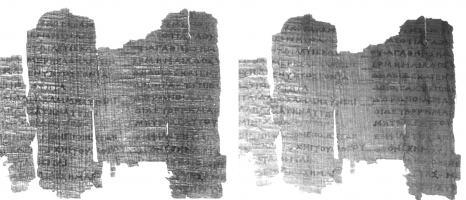Papyrus RTI case study
The Derveni tombs discovered in 1962 close to Thessaloniki in North Greece are considered one of the most significant archaeological sites in northern Greece because of their numerous rich grave offerings and their important location in the ancient Mygdonian city of Lete, on the pass of Via Egnatia. The cemetery comprises seven graves, and according to the excavation publication dates to 320–290 BC. One of the most remarkable finds of the Derveni Tombs is a papyrus roll, discovered in the remains of a funeral pyre above tomb A, a cist grave full of bronze and clay pots, vessels, jewellery and small objects (Themelis & Touratsoglou, 1997). The Derveni Papyrus fragments examined are preserved sandwiched between two sheets of glass. As a result the material integrity is safeguarded and the undesirable material deterioration due to handling is limited. At the same time, the glass mount poses a barrier in the study of the papyrus and affects visual analysis negatively. One of the most crucial features for the correct perception of information revealed from visual analysis is the perception of three-dimensionality, which in case of the Derveni papyrus is limited because of the glass mount. Another problem is the completely covering or the back side of the fragments, due to the backing material, which limits considerably the study of the material aspects of the papyrus.
One glass mount was captured in the conservation laboratories of the Archaeological Museum of Thessaloniki with reflected and transmitted illumination and infrared radiation, resulting in a series of RTI files. The front side of the glass mount was captured with visible reflected illumination and infrared radiation at 720nm, 850nm and 950nm. The back side of the papyrus was captured with reflected visible light and infrared radiation at 850nm, as well as with trans illumination and trans irradiation at 850nm. Data capture in the infrared spectral region was performed using IR light emitting diodes (LED), which do not accelerate thermal degradation. Following the mainstream methodology for H-RTI data capture is not possible. The reflections of the flash on the glass mount result in unacceptable images. This phenomenon takes place only in wider angles, so only low illumination angle data were used.
Common problems discussed by scholars, such as the buckling of the surface, the different layers of text stuck together with indistinguishable edges and the necessary movement of the papyrus in the hands of the expert so as for the letters to be revealed due to the different reflectance properties of the matte ink and the shiny papyrus background can be solved with RTI visualization. The synergy of RTI, Infrared imaging and trans illumination-irradiation enhances the readability and assists the overall diagnostic examination of the papyrus, the examination of the manufacture techniques, the determination of its condition and its possible conservation needs. IR-RTI proved to be a more efficient methodology compared to normal RTI. Not only it gave impressive results and enabled the reading of black letters on the darkened papyrus material more effectively but also emphasizes the three dimensional characteristics of the object and consequently assists the papyrus examination. Apart from documentation, restoration activities, reassembling and arrangement of the fragments can be benefited because the features which aid such processes, the continuity of writing, the shape of the handwriting, the design, the damage, the criss-cross pattern, the original joins and overlaps appear enhanced compared to normal (visible) RTI and/or infrared imaging.


The Derveni Papyrus fragment examined in this case study is stored in the Archaeological Museum of Thessaloniki.
Themelis, P., & Touratsoglou, I. (1997). Tafoi tou Derveniou. TAPA, Athens.

Leave a Reply